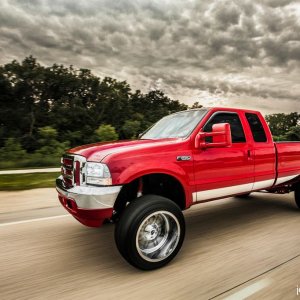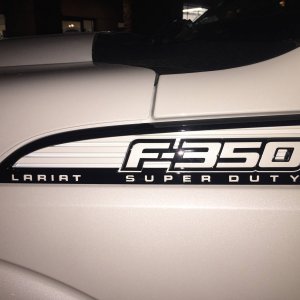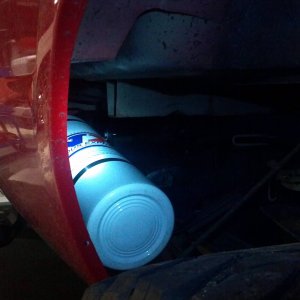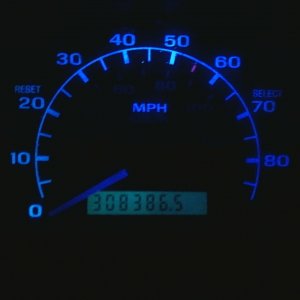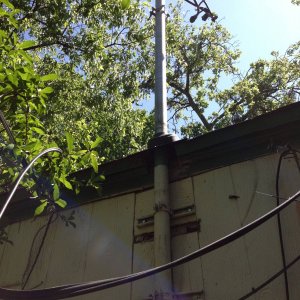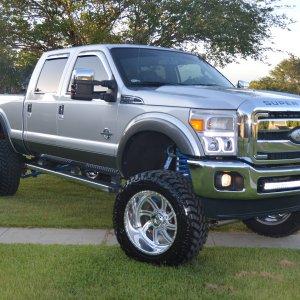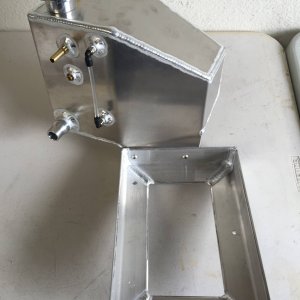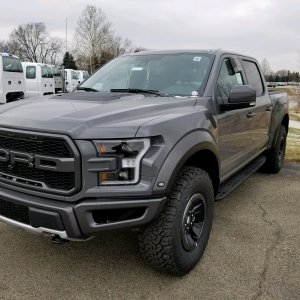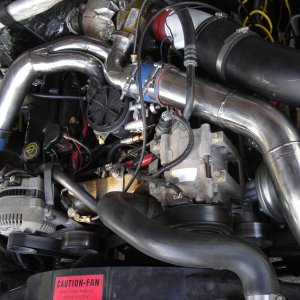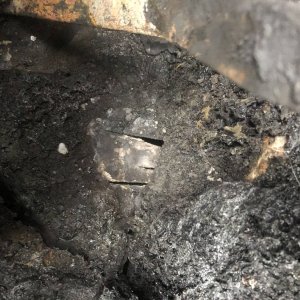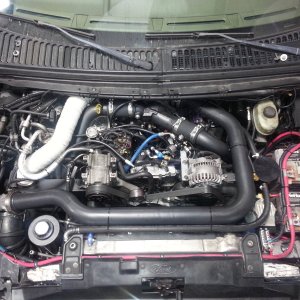Hey guys,
We recently decided to take a look at the issues surrounding the frequent radiator failures for the 6.4L, check out our findings below!
Mishimoto Radiator
After identifying the radiator as a common failure point on the Ford 6.4L Powerstroke, Mishimoto was quick to develop a full aluminum cooling solution for the plastic end-tank factory radiator. We are well aware of the widespread issues with stock radiator leaking at the end tanks, core, and hoses. Ford has attempted to remedy this issue throughout several years, releasing numerous TSB’s for a variety of cooling components.
The Mishimoto radiator has been finding its way into consumer trucks for over a year and we are proud to say we have developed a product that has ended the struggle for many Powerstroke owners. Our radiator features a very robust full aluminum construction. The efficient Mishimoto core is TIG welded to the radiator end-tanks which provides a huge increase in durability and longevity compared to the factory radiator which uses crimped on plastic end-tanks which are very prone to failure. Along with providing improved durability, our larger radiator doubles the coolant capacity of the stock radiator, taking it from 1.25 gallons to 2.5 gallons. This capacity increase, our efficient core, and the aluminum construction allows our product to provide improved cooling efficiency and heat dissipation.
With all of the success with this product, we have also had some warranty exchanges and defective units. You may have noticed a few customers on the forums with complaints regarding our radiators leaking. Fortunately these issues are very few, and we have a very low defect rate for the 6.4L radiator, well below industry standard. Because of the nature of this product, we have kept a very close eye on our warranties. Each unit is shipped to our testing facility where it is evaluated and a cause of failure is determined. We are looking for any trends or frequent failure points that can be improved. We take our returns/defects very seriously, we understand the impact these failures have on our customers as well as the outlook of our company.
As a few warranties came in, we began to notice that several customers had experienced failures with multiple Mishimoto radiators. This provided a clue that perhaps the vehicle has a fault which is causing repetitive failure. The chances of one customer receiving several defective products is incredibly slim. In order to properly diagnose the concern we would need to identify any other vehicle components which could directly impact the radiator or result in the failures experienced. This explains our decision to dig deeper into the design and function of both the radiator and cooling system.
With all of the failed factory units on the market and a few failures from our radiators, we were interested to see why this was continuing to occur. Several enthusiasts groups, experts, and vendors have offered up their opinion regarding the potential cause, however the actual cause is not entirely clear.
Our team decided it was time to bring in another vehicle to investigate several components which we think may be factors in the failure rate. Despite the fact that we have a great product and a very low defect rate, we are always interested in making improvements, making discoveries, and informing the community.
Prior to the arrival of our truck we set a few basic goals for what we wanted to achieve.
Goals
• Investigate and/or determine potential causes for radiator failure
• Attempt to replicate radiator failure under conditions anticipated by consumers
• Evaluate product design and adjust with any potential improvements
Testing Details
Prior to the arrival of our test-vehicle we checked the lengthy lineup of TSB’s released by Ford for various cooling system components on the 6.4L. This would provide some insight into what Ford was identifying as potential causes for failure. Our lead engineer for this project is Kevin, who designed this product from the beginning and is very familiar with the truck. Check out a few images of the truck!


Test 1: Road Testing For Temperature and Pressure Data
Our first test involves some time on the road. Before we began digging into any of the chassis flex issues mentioned on the forums, we wanted to closely monitor both coolant temperature and pressure during a variety of driving conditions. Based on failure rates, a spike in pressure or temperature could certainly have a direct result on the failure of the radiator seal or tank. First, we installed our sensors in both the upper and lower hose.


After completing the installation we set out for some road testing. Our engineers kept a close eye on both temperature and pressure to see if any substantial changes occurred. After 2 hours of mixed driving on both the highway and around town, we found 0 evidence of any spikes in either measurement. Although this does not completely rule out either of these causes of failure, it was a great test to see if a factory truck possesses any such faults or hinted at any changes in an over pressurized system.
Test 2: Testing Chassis and Radiator Support Flex
Our second round of testing is specific to some of the comments on the forums. Many sources are claiming that front suspension articulation is resulting in the flexing of the radiator support. This flexing is then transferred directly to the radiator which causes any weak points to crack or fail. This is a valid possibility, something we have witnessed first-hand with the 1995-2004 Ford Mustang. In that instance, we were able to develop a drop-in radiator with a unique bracketing system that properly isolated the radiator from the radiator support. This allowed for greater flex and eliminated the issues with the radiator twisting and failing.
To test this on the 6.4L, we would be checking the front suspension bushings as well as the radiator mounting points for flex during articulation. We captured video of the mounting point’s movement during a 2-foot suspension drop. Our results showed that although the mounts flexed quite a bit, nothing broke or bent during the process. This provided us with the information that the upper mounting points could use some form of optimization. This is something we will be addressing in a minor design alteration for our radiator.
Pre-Installation Radiator Checklist
With all of our testing and research complete, we developed a checklist for those with radiator concerns that will help reduce failure rates and eliminate the nightmare that is the 6.4L cooling system. By following these guidelines you can extend the life of your radiator, cooling system, and reduce vehicle downtime. This has been compiled in the best interest of our consumers and its completion is necessary prior to the installation of any radiator, whether it be a factory unit or the Mishimoto radiator.
Degas Bottle
1. Confirm if the coolant Degas Bottle has been updated from the 2-port design (Figure 1) to the single port design (Figure 2). If this update has been performed, be sure the radiator cap has been replaced with the single port unit.
2. If a single port Degas Bottle is installed, check the cap for nicks or cracks. If the cap is damaged in any way, be sure to replace this.
3. If a single port Degas Bottle is in place, ensure that the appropriate venture tee (Figure 3) connections are being used.
Coolant Leaks
4. Inspect all coolant hoses/components for leaks. Failed hose O-rings are quite common and are easily identified by a white residue (Figure 4). Failure prone points include connections at the radiator and engine. If any form of leaking exists, replace the effected hose with the updated double O-ring design (Figure 5). If the hoses are removed for any reason, be sure to check the O-rings for damage prior to reinstallation.
Thermostat
5. Factory thermostats are prone to overextension which results in thermal spikes within the radiator and potential damage. Remove the factory thermostat housing and inspect the bypass thermostat for extension distance from the mounting surface (Figure 6). This distance should be no greater than 45mm. In the case that this distance is greater than 45mm, replace the thermostat.
Refilling Coolant
6. When refilling the coolant system, be sure to use a radiator refiller such as the Airlift Refill Tool recommended by Ford. If this device is not used, air pockets in the system can exist and result in low fluid levels.
7. Check the coolant level after a few cycles of bringing the truck to operating temperature and back to ambient. Proper coolant level is vital for this system and should be between the two lines on the Degas Bottle when the engine is cold. From our experience, obtaining the proper level of coolant and air pocket elimination will take approximately 2-4 warmup cycles.
Bushing Inspection
8. Check the upper radiator mounting peg bushings for damage. These bushings (Figure 7 & 8) should be pliable and free of any cracking or tears. If these bushings are damaged, replace them with OEM components.
9. Check the cab isolators on the front of the vehicle. Perform a visual inspection to ensure that they are not worn or damaged (Figure 9). If they are worn, replace them prior to radiator installation.
Part Replacements
10. Reference the factory part number chart below if any updates are necessary for your vehicle.

Reference Images

Figure 1

Figure 2

Figure 3

Figure 4

Figure 5

Figure 6

Figure 7

Figure 8

Figure 9
Ongoing Improvements
As mentioned previously, our radiator design is extremely durable and efficient. The Mishimoto radiator provides a huge improvement over the failure-prone factory units. During our evaluation and testing, we determined that a minor adjustment to the upper mounting points will aid in reducing the transfer of flex from the radiator support to the end-tanks. This modification will be a running change in production.
Now that we have a better understanding of the 6.4L cooling system we can provide our customers with the tips and steps to reduce the chances of radiator failure. Please reference the maintenance check list above which will ensure your truck is prepared for radiator installation and all preventative measures have been taken to reduce the chances of an additional failure.
Our goal is to keep your truck on the road and out of the shop.
If you have any questions regarding our testing, pre-installation checklist, or our radiator, feel free to contact our CSR team with any questions!
Thanks
-John Marsteller
Mishimoto Automotive
We recently decided to take a look at the issues surrounding the frequent radiator failures for the 6.4L, check out our findings below!
Mishimoto Radiator
After identifying the radiator as a common failure point on the Ford 6.4L Powerstroke, Mishimoto was quick to develop a full aluminum cooling solution for the plastic end-tank factory radiator. We are well aware of the widespread issues with stock radiator leaking at the end tanks, core, and hoses. Ford has attempted to remedy this issue throughout several years, releasing numerous TSB’s for a variety of cooling components.
The Mishimoto radiator has been finding its way into consumer trucks for over a year and we are proud to say we have developed a product that has ended the struggle for many Powerstroke owners. Our radiator features a very robust full aluminum construction. The efficient Mishimoto core is TIG welded to the radiator end-tanks which provides a huge increase in durability and longevity compared to the factory radiator which uses crimped on plastic end-tanks which are very prone to failure. Along with providing improved durability, our larger radiator doubles the coolant capacity of the stock radiator, taking it from 1.25 gallons to 2.5 gallons. This capacity increase, our efficient core, and the aluminum construction allows our product to provide improved cooling efficiency and heat dissipation.
With all of the success with this product, we have also had some warranty exchanges and defective units. You may have noticed a few customers on the forums with complaints regarding our radiators leaking. Fortunately these issues are very few, and we have a very low defect rate for the 6.4L radiator, well below industry standard. Because of the nature of this product, we have kept a very close eye on our warranties. Each unit is shipped to our testing facility where it is evaluated and a cause of failure is determined. We are looking for any trends or frequent failure points that can be improved. We take our returns/defects very seriously, we understand the impact these failures have on our customers as well as the outlook of our company.
As a few warranties came in, we began to notice that several customers had experienced failures with multiple Mishimoto radiators. This provided a clue that perhaps the vehicle has a fault which is causing repetitive failure. The chances of one customer receiving several defective products is incredibly slim. In order to properly diagnose the concern we would need to identify any other vehicle components which could directly impact the radiator or result in the failures experienced. This explains our decision to dig deeper into the design and function of both the radiator and cooling system.
With all of the failed factory units on the market and a few failures from our radiators, we were interested to see why this was continuing to occur. Several enthusiasts groups, experts, and vendors have offered up their opinion regarding the potential cause, however the actual cause is not entirely clear.
Our team decided it was time to bring in another vehicle to investigate several components which we think may be factors in the failure rate. Despite the fact that we have a great product and a very low defect rate, we are always interested in making improvements, making discoveries, and informing the community.
Prior to the arrival of our truck we set a few basic goals for what we wanted to achieve.
Goals
• Investigate and/or determine potential causes for radiator failure
• Attempt to replicate radiator failure under conditions anticipated by consumers
• Evaluate product design and adjust with any potential improvements
Testing Details
Prior to the arrival of our test-vehicle we checked the lengthy lineup of TSB’s released by Ford for various cooling system components on the 6.4L. This would provide some insight into what Ford was identifying as potential causes for failure. Our lead engineer for this project is Kevin, who designed this product from the beginning and is very familiar with the truck. Check out a few images of the truck!
Test 1: Road Testing For Temperature and Pressure Data
Our first test involves some time on the road. Before we began digging into any of the chassis flex issues mentioned on the forums, we wanted to closely monitor both coolant temperature and pressure during a variety of driving conditions. Based on failure rates, a spike in pressure or temperature could certainly have a direct result on the failure of the radiator seal or tank. First, we installed our sensors in both the upper and lower hose.
After completing the installation we set out for some road testing. Our engineers kept a close eye on both temperature and pressure to see if any substantial changes occurred. After 2 hours of mixed driving on both the highway and around town, we found 0 evidence of any spikes in either measurement. Although this does not completely rule out either of these causes of failure, it was a great test to see if a factory truck possesses any such faults or hinted at any changes in an over pressurized system.
Test 2: Testing Chassis and Radiator Support Flex
Our second round of testing is specific to some of the comments on the forums. Many sources are claiming that front suspension articulation is resulting in the flexing of the radiator support. This flexing is then transferred directly to the radiator which causes any weak points to crack or fail. This is a valid possibility, something we have witnessed first-hand with the 1995-2004 Ford Mustang. In that instance, we were able to develop a drop-in radiator with a unique bracketing system that properly isolated the radiator from the radiator support. This allowed for greater flex and eliminated the issues with the radiator twisting and failing.
To test this on the 6.4L, we would be checking the front suspension bushings as well as the radiator mounting points for flex during articulation. We captured video of the mounting point’s movement during a 2-foot suspension drop. Our results showed that although the mounts flexed quite a bit, nothing broke or bent during the process. This provided us with the information that the upper mounting points could use some form of optimization. This is something we will be addressing in a minor design alteration for our radiator.
Pre-Installation Radiator Checklist
With all of our testing and research complete, we developed a checklist for those with radiator concerns that will help reduce failure rates and eliminate the nightmare that is the 6.4L cooling system. By following these guidelines you can extend the life of your radiator, cooling system, and reduce vehicle downtime. This has been compiled in the best interest of our consumers and its completion is necessary prior to the installation of any radiator, whether it be a factory unit or the Mishimoto radiator.
Degas Bottle
1. Confirm if the coolant Degas Bottle has been updated from the 2-port design (Figure 1) to the single port design (Figure 2). If this update has been performed, be sure the radiator cap has been replaced with the single port unit.
2. If a single port Degas Bottle is installed, check the cap for nicks or cracks. If the cap is damaged in any way, be sure to replace this.
3. If a single port Degas Bottle is in place, ensure that the appropriate venture tee (Figure 3) connections are being used.
Coolant Leaks
4. Inspect all coolant hoses/components for leaks. Failed hose O-rings are quite common and are easily identified by a white residue (Figure 4). Failure prone points include connections at the radiator and engine. If any form of leaking exists, replace the effected hose with the updated double O-ring design (Figure 5). If the hoses are removed for any reason, be sure to check the O-rings for damage prior to reinstallation.
Thermostat
5. Factory thermostats are prone to overextension which results in thermal spikes within the radiator and potential damage. Remove the factory thermostat housing and inspect the bypass thermostat for extension distance from the mounting surface (Figure 6). This distance should be no greater than 45mm. In the case that this distance is greater than 45mm, replace the thermostat.
Refilling Coolant
6. When refilling the coolant system, be sure to use a radiator refiller such as the Airlift Refill Tool recommended by Ford. If this device is not used, air pockets in the system can exist and result in low fluid levels.
7. Check the coolant level after a few cycles of bringing the truck to operating temperature and back to ambient. Proper coolant level is vital for this system and should be between the two lines on the Degas Bottle when the engine is cold. From our experience, obtaining the proper level of coolant and air pocket elimination will take approximately 2-4 warmup cycles.
Bushing Inspection
8. Check the upper radiator mounting peg bushings for damage. These bushings (Figure 7 & 8) should be pliable and free of any cracking or tears. If these bushings are damaged, replace them with OEM components.
9. Check the cab isolators on the front of the vehicle. Perform a visual inspection to ensure that they are not worn or damaged (Figure 9). If they are worn, replace them prior to radiator installation.
Part Replacements
10. Reference the factory part number chart below if any updates are necessary for your vehicle.
Reference Images
Figure 1
Figure 2
Figure 3
Figure 4
Figure 5
Figure 6
Figure 7
Figure 8
Figure 9
Ongoing Improvements
As mentioned previously, our radiator design is extremely durable and efficient. The Mishimoto radiator provides a huge improvement over the failure-prone factory units. During our evaluation and testing, we determined that a minor adjustment to the upper mounting points will aid in reducing the transfer of flex from the radiator support to the end-tanks. This modification will be a running change in production.
Now that we have a better understanding of the 6.4L cooling system we can provide our customers with the tips and steps to reduce the chances of radiator failure. Please reference the maintenance check list above which will ensure your truck is prepared for radiator installation and all preventative measures have been taken to reduce the chances of an additional failure.
Our goal is to keep your truck on the road and out of the shop.
If you have any questions regarding our testing, pre-installation checklist, or our radiator, feel free to contact our CSR team with any questions!
Thanks
-John Marsteller
Mishimoto Automotive

